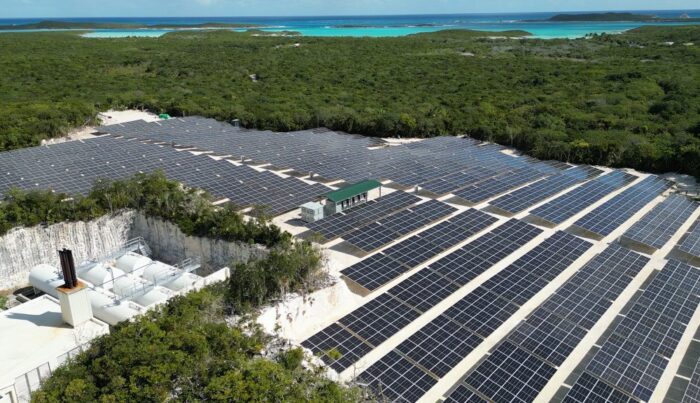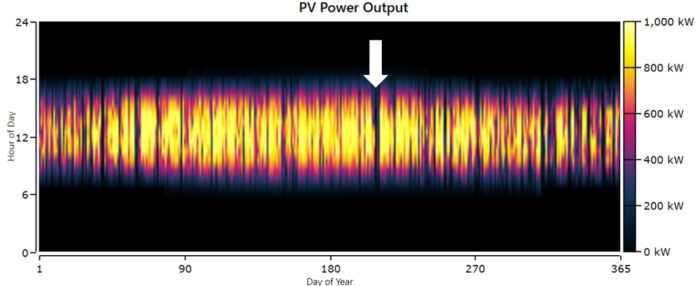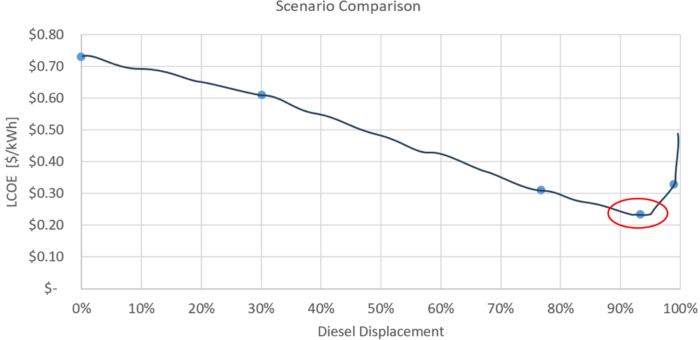Microgrid mythbusting: How to design a financially sound microgrid

By Marc Lopata, PE | Solar Island Energy
Much of my time at work involves helping folks understand how they can improve their energy and financial performance using microgrids. That is mostly solar energy and batteries and energy efficiency. But sometimes we also integrate wind turbines, ice energy storage, flywheels, fuel cells, and other bleeding edge technologies. The overwhelming number of those projects are small island communities that are burning diesel fuel to make electricity, and we displace most of that diesel fuel with solar energy.
Along with other practitioners, we are making microgrids mainstream. We are still in the early adopter phases, and accurate knowledge is key to moving to mainstream adoption.
- Is your client a business owner using high-precision manufacturing with robotics and 3-D printers? One of their primary concerns probably is power quality from the utility grid.
- Or maybe your client’s business is cold storage, and they’re similarly concerned about losing the grid and their inventory because of an outage. This same concern might resonate with hospitals, military bases, data centers, and other electricity users that need reliable electricity and can’t tolerate the lights going out.
- Or maybe your client lives or works somewhere with no grid at all.
These are all reasons to consider using a microgrid to provide reliable electricity. But is a microgrid worth it? That depends on the financial or non-financial benefits that make sense to your client, whether that is a return on investment or keeping lights on at night so people can read and cook without burning fires in their homes.
Just like any technological advancement, there are misconceptions about microgrids. This article will explain a few of them, mostly as they relate to small island communities. But they would still apply to those other microgrid use cases.
What is a microgrid?
Ask five experts and you might get five answers. I like to keep things simple, so how about this:
- A group of electricity users relatively close to each other.
- The ability to generate and store energy to use it when needed.
- The generation and storage assets may be centralized or distributed around the various users (nodes) of the microgrid, and they are centrally controlled to manage overall performance.
- There also may be the desire to connect to, or disconnect from, a public utility grid based on financial, reliability, or other drivers.
Can you still call your one building by itself a microgrid? Of course. There’s no microgrid police. Fundamentally, we are referring to the technology that enables the above bulleted items, not whether an application takes advantage of them all.
Myth 0: Microgrid technology is the key
Let’s get this out of the way first. Two important steps will make all the difference in whether a microgrid is successful.
First is an accurate base-load profile. How much energy does the microgrid site use every year, every day, every hour? Ultimately, this hourly data, an “8760 data set,” will be needed. Whether you get that from a data logging system or synthesize it (guess) from singular, long-term metrics will affect the success of the project. For instance, we sometimes get a client that tells us, “We spent $500,000 on diesel fuel last year.” Can we create a load profile from that? Yes. Will it be accurate? Maybe. GIGO (Garbage In / Garbage Out) applies here.
Second is the energy efficiency of the microgrid. This is like dieting, and no one likes to do it for the same reasons. Lighting and operations usually are easy targets. Other energy efficiency efforts become more complex and costly and are usually not as good financial metrics — but it is still important to consider them all because it is much more expensive to make a kWh with a microgrid than to reduce consumption. Energy efficiency likely requires another article to itself.
Myth 1: A solar energy microgrid can make 100% of your electricity from solar only
This statement is true mostly in two limited use cases.
- The users say it is OK that when the batteries are depleted, the lights will go out.
- The project has a huge budget, no expectation of financial performance, and no limitations on land area.
The military or wealthy landowners will tell you that use case No. 2 is the way they operate. But it is my experience that most folks aren’t happy when the lights go out, and/or they do not have abundant land or money, and they are actually concerned about financial performance.
If an industry is to grow, isn’t financial sustainability just as important as other benefits? Yes, the early adopters, bless their hearts, are more focused on proof of concept and do have abundant budgets. But to get to mainstream, we have to deliver performance that will drive a typical client to invest.
Here’s a thought exercise to help understand this myth. Consider making all of your electricity with PV on a sunny day. If it were sunny every day where you live, and you needed the same amount of electricity every day, it would be easy to design that 100% offset microgrid.
But that isn’t the case. Do you live in the Caribbean? Phoenix? Colorado? Clouds exist everywhere sometimes. It even rains in Southern California.
For those once-in-a-while cloudy days, you would have to pretty much double the size of the PV and ESS to remain 100% renewable. If it happens to be cloudy two days in a row, then the PV and ESS would need to be three times the original size. And so on.
At some point, the economics and business case for land use don’t work so well. If it is cloudy one day a month, is it worth it to double the size and cost for 12 cloudy days a year? How about if it is cloudy one day a week? Or how about if there’s also a spike in energy usage on a cloudy day? The site could get to the point where the solar just can’t meet the demand, and the lights go out.
Refer to the graph below. Here is the energy and power produced by a typical solar energy system over the course of a year. The calendar day is the X-axis along the bottom from January to December. The time of day is vertical on the Y-axis going from morning to night. The brighter the color, the more power and energy the solar is producing.

The variability is because of clouds mostly but also temperature. Obviously, the sun isn’t shining at night, and that is why the night hours are black. But the sun power isn’t consistent during the sun hours either. The white arrow points to the end of July and it looks like there isn’t any production there for a few days. This would be the same if the site was using wind turbines. Sometimes the wind doesn’t blow.
Levelized Cost of Energy (LCOE) is a key microgrid metric. It is the cost of energy from the microgrid considering all the costs and all the energy produced. That includes the initial capital investment, plus all future costs. The future costs are maintenance (for everything), replacing equipment when its warranty expires, overhauling engines, and of course, fuel. Then, all the future costs are discounted to today’s dollars. (If you aren’t sure what that means, look up “present value of a cash flow stream.”)
Once the total net present cost is calculated, divide that by the total energy produced over the project lifecycle. That results in a cost per unit of energy, or $ per kWh.
Below is a graph of the LCOE vs. increasing percentages of fossil fuel or utility offset. In this example, the lowest LCOE (LLCOE) is around $0.25/kWh and that happens at around 93% diesel
displacement.

The left side of the curve is electricity sourced the same old way using your favorite fossil fuel or utility supply. Moving to the right increases the displacement or offset of fossil fuels by solar energy. A hypothetical 100% diesel offset would be the far-right side of the curve where it is moving at a sharp vertical. These days, with the price of fuel and utilities, the sweet spot often turns out to be around 90% of fossil-fuel displacement. Aiming higher than that can double the land area required for the solar array and double the cost of energy because of those strings of cloudy days. Oversizing PV and ESS to this degree also means a lot of “excess energy” on sunny days that can’t be used and an investment in assets that aren’t making any returns.
In Myth 2, we will see a typical site that uses 1,000 kWh a day on average. The LLCOE microgrid for a typical fuel cost is 240 kWdc of PV and 700 kWh of ESS. That offsets around 90% of the diesel fuel. If we instead aim for 100% diesel offset, that is 500 kWdc of PV (2x the LLCOE investment) and 1,800 kWh of ESS (2.5x the LLCOE investment). The LLCOE microgrid has excess energy of about 9%, meaning that over the course of a year, 9% of the energy is wasted. The 100% solar microgrid has about 55% excess energy.
That is a hard financial pill to swallow.
Getting to that 100% renewable point definitely makes the cost of energy higher. It also requires more space for the PV array (or more wind turbines). Energy efficiency definitely helps, but even after accounting for an energy diet, it is more practical and cost effective to meet demand on those high-demand and cloudy days using the backup generators or the grid.
Keep reading in the Q2 2025 issue of Solar Builder
Enter info below for instant access to the digital edition, and opt-in to a free subscription of Solar Builder magazine.
Marc Lopata is president of Solar Island Energy. He is a licensed Professional Engineer and NABCEP-certified PV Installer and Inspector. His portfolio as engineer-of-record, owner’s agent, or onsite construction supervisor includes over 700 solar projects, 20 utility PV and battery projects and 80 microgrid and energy storage projects. He has been a technical advisor to the World Bank, contributing author to both “Solar Under Storm” manuals, and a peer reviewer on hurricane survivability for the National Renewable Energy Laboratory. Solar Island Energy works mostly with island communities that make electricity by burning diesel fuel; helping them implement solar energy microgrids and energy efficiency improvements.




